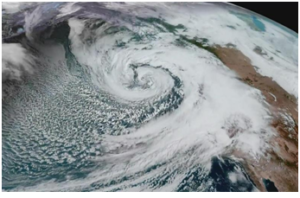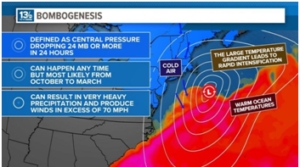Ethics Theory, TLP-UPSC Mains Answer Writing
Q. 16. What is a bomb cyclone? Explain the meteorological conditions that lead to its formation and discuss its potential impacts. (250 words, 15 marks)
Introduction
Coined in 1979, the term bomb cyclone emerged from the concept of “explosive cyclogenesis”—mid-latitude storms that rapidly intensify with pressure drops of ≥24 millibars in 24 hours, resembling the suddenness and impact of a bomb explosion.
Body
Meteorological Conditions for Formation
- Pressure Instability: Interaction between cold polar air and warm tropical air creates strong pressure gradients.
- Rapid Pressure Drop: A deep low-pressure system experiences bombogenesis, causing pressure to fall ≥24 millibars in one day.
- Jet Stream Influence: Strong upper-level jet stream divergence enhances vertical air movement, accelerating intensification.
- Warm Ocean Waters: Supply latent heat and moisture, fuelling cyclogenesis, especially over the North Atlantic or Pacific.
- Seasonal Factors: Often occurs during late fall to early spring, when temperature contrasts between land and ocean are maximum.

Potential Impacts of Bomb Cyclones
- Hurricane-like Winds: Gale-force winds (>100 km/h) can cause structural damage and power outages.
- Heavy Snowfall or Rain: Leads to blizzards or flash floods, depending on the region and temperature.
- Coastal Storm Surges: Coastal areas face flooding and erosion, especially along low-lying shores.
- Transportation Disruption: Air, road, and rail transport can be paralysed by extreme weather.
- Economic Losses: Damages to infrastructure, agriculture, and energy sectors can be substantial, especially in densely populated coastal regions.

Conclusion
Bomb cyclones are intensifying with changing climate patterns. Investing in satellite-based monitoring, AI-driven models, and robust early warning systems is vital to reduce disaster risks and adapt to the growing frequency of extreme weather events.













